
New York Journal of Mathematics
metrics 2024
Fostering innovation in the world of mathematics.
Introduction
New York Journal of Mathematics is a prominent open-access journal, published by the ELECTRONIC JOURNALS PROJECT, dedicated to advancing the field of mathematics through the dissemination of groundbreaking research. Since its inception in 1996, the journal has evolved into a valuable resource for researchers, educators, and students, particularly in the realm of general mathematics. As of 2023, it proudly holds a Q2 classification in the Mathematics (miscellaneous) category, reflecting its growing impact and reach within the academic community, despite being ranked at the 31st percentile overall. With its commitment to open access since 2022, the journal ensures that high-quality mathematical research is readily available to a global audience, fostering collaboration and innovation. Researchers interested in contributing to this dynamic field will find the journal a vital platform for sharing their findings and engaging with fellow mathematicians around the world.
Metrics 2024
 0.48
0.48 0.40
0.40 0.50
0.50 30
30Metrics History
Rank 2024
Scopus
IF (Web Of Science)
JCI (Web Of Science)
Quartile History
Similar Journals

Muenster Journal of Mathematics
Fostering interdisciplinary innovation in mathematics.Muenster Journal of Mathematics, published by the Westfälische Wilhelms-Universität Münster, Mathematics Institute, serves as a prominent platform for advancing research in pure and applied mathematics. With an ISSN of 1867-5778 and an E-ISSN of 1867-5786, this journal is dedicated to fostering interdisciplinary collaboration among mathematicians, statisticians, and theoretical researchers. While currently not operating under an open access model, the journal ensures that esteemed research contributions undergo rigorous peer review, maintaining high academic standards and integrity. The journal's commitment to disseminating innovative mathematical ideas is reflected in its diverse scope, encompassing fields such as algebra, topology, analysis, and applied mathematics. As a vital resource for researchers, professionals, and students alike, Muenster Journal of Mathematics plays a crucial role in shaping the future of mathematical sciences and fostering scholarly dialogue. The journal welcomes submissions that provide novel insights and methodologies, thereby encouraging the exploration of complex mathematical concepts.
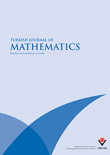
Turkish Journal of Mathematics
Elevating Mathematics: From Theory to ApplicationTurkish Journal of Mathematics is a prestigious academic publication dedicated to the advancement of mathematical research across a variety of subfields. Established in 1995 and published by the Tubitak Scientific & Technological Research Council Turkey, this journal has built a solid reputation, especially noted for its significant contributions to the field over the years, with its convergence spanning from 1995 to 2002 and again from 2006 to 2024. The journal, which holds a commendable Q2 ranking in Mathematics (miscellaneous) and is positioned in the 66th percentile of Scopus rankings for General Mathematics, aims to disseminate high-quality original research, reviews, and innovative methodologies to advance both theoretical and applied mathematics. Researchers, professionals, and students alike will find invaluable resources within its pages, providing insights that are pivotal for academic and practical applications in mathematics. Although it does not currently offer open access options, the journal remains an essential platform for those looking to engage with the forefront of mathematical inquiry.
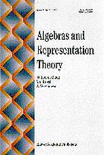
ALGEBRAS AND REPRESENTATION THEORY
Elevating Scholarship in Algebra and Representation TheoryALGEBRAS AND REPRESENTATION THEORY, published by SPRINGER, is a premier journal that focuses on the cutting-edge developments in the field of algebra and representation theory. With an ISSN of 1386-923X and an E-ISSN of 1572-9079, this journal has fostered a robust platform for both established and emerging researchers since its inception in 1998. As a Q1 journal in the Mathematics miscellaneous category for 2023, it stands out for its rigorous peer-review process and commitment to academic excellence. Although it is not an open-access journal, its broad scope includes significant theoretical advancements and applications that resonate across various mathematical disciplines. Located at VAN GODEWIJCKSTRAAT 30, 3311 GZ DORDRECHT, NETHERLANDS, ALGEBRAS AND REPRESENTATION THEORY continues to contribute meaningfully to the scientific community by providing researchers with essential insights and fostering collaboration in the increasingly complex landscape of mathematics. Researchers, professionals, and students are encouraged to engage with the latest publications, as the journal plays a critical role in shaping contemporary discussions and innovations in the study of algebraic structures.
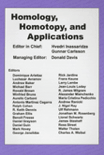
Homology Homotopy and Applications
Unlocking New Dimensions in Mathematical SciencesHomology Homotopy and Applications is a prestigious peer-reviewed journal published by INT PRESS BOSTON, INC, dedicated to advancing the field of mathematics, particularly within the realms of algebraic topology, homological algebra, and their applications. With an impressive Q1 classification in the mathematics category for the year 2023, this journal serves as a crucial platform for researchers, professionals, and students aiming to disseminate their findings in a rapidly evolving discipline. Although open access options are not currently available, the journal retains significant value with its rigorous selection process and high-impact studies. The journal invites submissions that explore theoretical developments as well as practical applications that bridge homology and homotopy theories, thus contributing to the broader scientific community from its base in the United States. With convergence covering years from 2001 to 2024, Homology Homotopy and Applications continues to be a vital resource for fresh insights and groundbreaking research in mathematical sciences.

Selecta Mathematica-New Series
Advancing Understanding in Dynamic Scientific Fields.Selecta Mathematica-New Series is a premier academic journal published by Springer International Publishing AG, based in Switzerland. With an impressive impact in the fields of Mathematics and Physics, it is recognized in the Q1 category for both Mathematics (Miscellaneous) and Physics and Astronomy (Miscellaneous) as of 2023. Established in 1995, the journal provides a platform for rigorous peer-reviewed research, facilitating the dissemination of groundbreaking findings and theoretical advancements through its converged publication years up to 2024. Researchers and scholars seeking to stay at the forefront of mathematical and physical sciences will benefit from the journal's diverse scope and high-impact articles. Although it does not operate under an open-access model, Selecta Mathematica-New Series remains a vital resource for building knowledge and fostering collaboration among professionals and students engaged in these dynamic fields. Access to its content is essential for those aiming to deepen their understanding and contribute to the ongoing dialogue within the scientific community.
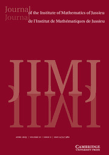
Journal of the Institute of Mathematics of Jussieu
Connecting Scholars Through Cutting-edge Mathematical ResearchJournal of the Institute of Mathematics of Jussieu, published by Cambridge University Press, is a leading academic journal that has established itself as a vital resource in the field of mathematics. With an impressive impact factor and a ranking in the top quartile (Q1) of miscellaneous mathematics, the journal serves as a platform for high-quality research from both established scholars and emerging researchers. Spanning from 2002 to 2024, the journal aims to foster collaboration and innovation in the mathematical community by publishing original research articles, reviews, and critical discussions on a wide range of mathematical topics. Although the journal does not offer open access, it remains widely accessible through various academic institutions and libraries, ensuring that critical advancements in mathematics are shared with a global audience. Located in the United Kingdom at the prestigious Cambridge campus, the journal reflects the rigorous standards of its publisher and the rich academic tradition of its home institution.

RENDICONTI DEL SEMINARIO MATEMATICO DELLA UNIVERSITA DI PADOVA
Exploring the frontiers of mathematics with open access insights.RENDICONTI DEL SEMINARIO MATEMATICO DELLA UNIVERSITA DI PADOVA, published by the European Mathematical Society, stands as a notable open-access journal with a rich history in disseminating research across various domains of mathematics. With an ISSN of 0041-8994 and E-ISSN 2240-2926, this journal has embraced open access since 2023, significantly enhancing its visibility and accessibility to a global audience. Situated in Germany, its publishing house is based at Technical University Berlin, which emphasizes its academic roots and dedication to fostering mathematical research. The journal features a quartile ranking of Q3 across multiple categories including Algebra and Number Theory, Analysis, Geometry and Topology, and Mathematical Physics as of 2023, indicating a vibrant contribution to the field, despite its challenge in specific rankings. Researchers, professionals, and students alike will find in this journal a platform for innovative ideas and significant findings that are crucial to the evolution of modern mathematics.
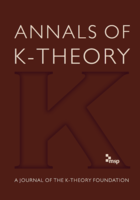
Annals of K-Theory
Shaping the Future of Mathematical Research and CollaborationAnnals of K-Theory, published by Mathematical Science Publishers, is an esteemed academic journal that serves as a vital platform for advancing research in the fields of analysis, geometry, and topology. Since its inception in 2016, the journal has successfully merged rigorous mathematical exploration with practical application, catering to a diverse audience of researchers, professionals, and students. With an impressive track record as a Q2 journal in Analysis and Geometry and Topology, and achieving a Q1 ranking in Assessment and Diagnosis in 2023, Annals of K-Theory continues to be recognized for its significant contributions to the mathematical sciences community. Although currently not open access, the journal provides relevant and accessible content that encourages rigorous dialogue and collaboration among mathematicians. As indicated by its Scopus rankings, it holds a commendable position within its field, demonstrating a commitment to quality research that pushes the boundaries of mathematical knowledge and application.
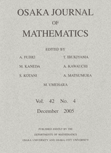
OSAKA JOURNAL OF MATHEMATICS
Exploring New Dimensions of Mathematical KnowledgeOSAKA JOURNAL OF MATHEMATICS, established in 1949 and published from Japan, stands as a reputable platform dedicated to advancing the field of mathematics. With an ISSN of 0030-6126, this journal showcases research in various mathematical disciplines, contributing significantly to both theoretical and applied mathematics. Though it currently holds a Q3 designation in the miscellaneous mathematics category, the journal aims to enhance its impact and visibility within the academic community. Researchers can benefit from the latest insights and findings, making it an essential read for anyone involved in mathematical studies. The journal emphasizes quality over quantity, providing a selective peer-reviewed process that ensures rigorous academic standards. Furthermore, while it is not an open-access journal, it maintains a commitment to disseminating valuable mathematical knowledge across the globe, serving the scholarly community through traditional subscription-based access. OSAKA JOURNAL OF MATHEMATICS is an invaluable resource for professionals, researchers, and students seeking to stay at the forefront of mathematical research and discussions.
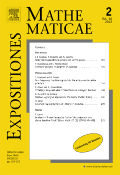
EXPOSITIONES MATHEMATICAE
Championing Excellence in Mathematical ScholarshipEXPOSITIONES MATHEMATICAE, published by Elsevier GmbH, stands as a significant journal in the realm of mathematics, catering primarily to researchers, professionals, and students. With an ISSN of 0723-0869 and an E-ISSN of 1878-0792, this journal has made its mark in the academic community, boasting a Q2 classification in the miscellaneous mathematics category for 2023, illustrating its prominence within its field. The journal addresses a diverse scope of mathematical topics, encouraging the publication of original research and innovative theories while maintaining rigorous academic standards. As it converges from 2004 to 2024, EXPOSITIONES MATHEMATICAE continues to be an essential resource for advancing mathematical knowledge and fostering scholarly communication, despite being a non-open-access publication. Its location in Munich, Germany further anchors it within a rich intellectual tradition, providing accessibility for the mathematical community worldwide.